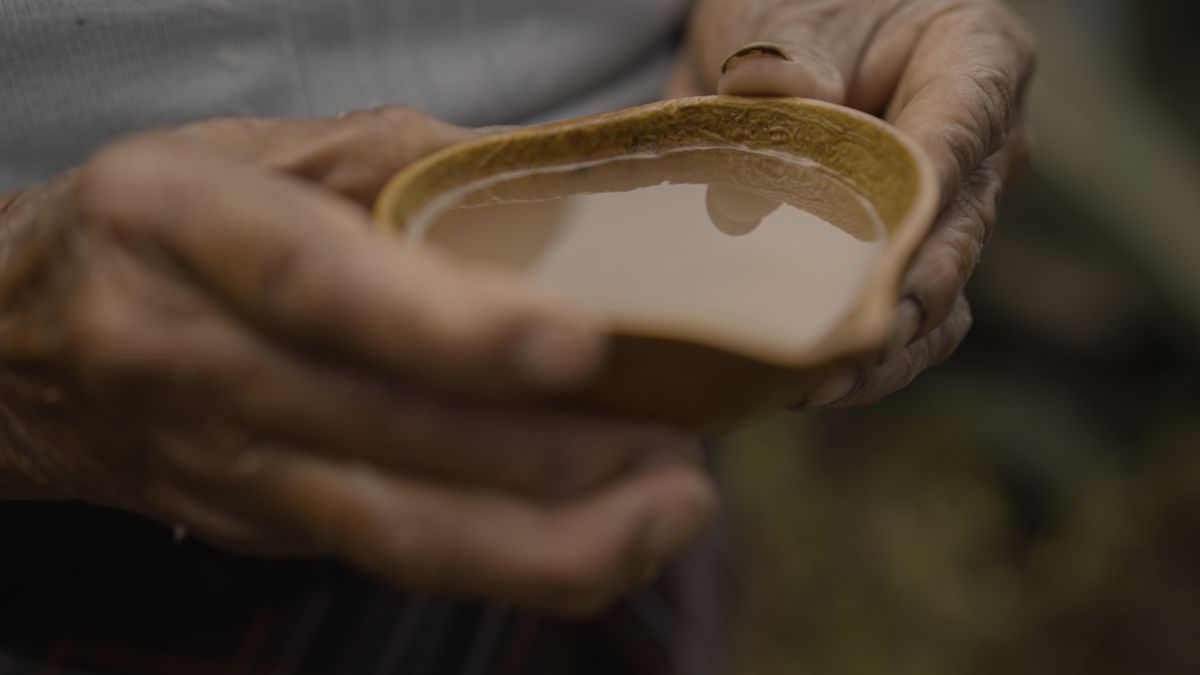Chaguarmishqui is of indigenous origin and one of the oldest drinks in the Americas, but also the most vilified drink because it was considered a drink of the so-called Indians, i.e. the indigenous people of the Andes. The distillate, Miske or Miské, made predominantly by women, is the only Ecuadorian drink with the Ecuador designation of origin.
In the so-called middle of the world, more precisely at the latitude 00º 00′ 00″, there is a small distillery where the juice of the American agave cactus or blue agave from the Agavaceae family is distilled. Located on the land that separates the two hemispheres, Casa Agave was born from the claim of an ancient drink with an ancient tradition that originated in the middle of the Andes and has been part of the local culture since the founding of the first half of the cities. Natives of Quito.
The prehistoric cactus
 Mishquera collects the Chaguarmishqui, in a picture from Casa Agave.
Mishquera collects the Chaguarmishqui, in a picture from Casa Agave.
“This cactus is a plant dinosaur, it is a prehistoric plant. Agave juice has been a wild food and drink for Andean residents for thousands of years; The same thing happens in Mexico, where there is a really strong ancestral agave culture, with the difference that what is called pulque there is called miske in Ecuador,” explains Diego Mora, owner and mishquero of Casa Agave. Although it was denigrated as the water of the Indians or the poor, its importance began to be lost within Ecuadorian culture. Little by little, the task of the Mishquero, the person who had all the necessary knowledge for the extraction of Chaguarmishqui, was left aside until Don Virgilio Collahuazo remained the last Mishquero in Ecuador. Diego Mora learned everything from him when he came to the valleys of Quito 22 years ago to restore and appreciate this ancestral Andean heritage. This is how Casa Agave was born, a project that not only focuses on saving this Ecuadorian cultural and gastronomic tradition in the hands of nine communities, but also strives to restore a very special plant native to the Americas and typical of the region.
More information
“Indigenous people have a special connection to their land and to products such as agave, a plant considered a god and on whose leaves they write wishes,” explains Mora. And there are more than 300 species of agave distributed throughout Central and South America. Some of its species are used for juice extraction and the production of distillates; others allow their pulp to be used in cooking; Certain varieties are used exclusively for the use of their fibers in the production of crafts, paper and textiles. Its roots contain a saponin-like substance and are used as soap. Even household items and even houses are built from its wood. However, according to this Mishquero, it is in Ecuador that it develops at its best quality since, thanks to its location, “the plants have vertical light 365 days a year, which translates into sugars that help in their distillation”.
Water of the poor
 Diego Mora from Casa Agave, in an image provided by the distillery.
Diego Mora from Casa Agave, in an image provided by the distillery.
Its uniqueness is that the plant must be at least ten years old to collect the juice called Chaguarmishqui, which can be drunk without any process. “Only the inside is cut and the liquid inside is collected. This action is carried out two to three times a day for four months, obtaining around ten liters a day,” explains the producer. “Chaguarmishqui is a nutritious drink that was previously used for hydration, to treat stomach problems and to promote healthy and strong growth in children.” Nine Mishqueras from different indigenous communities who are over 60 years old are responsible for its production. “Casa Agave is also a social, ecological and cultural project. The women of these communities are heads of families who, for the first time in history, are able to support their families. It is a silent female revolution and is realized through the creation of one of the most sustainable products in Ecuador, since the agave grows in desert areas and stony soils where it needs nothing,” explains Mora.
From reforestation to designation of origin
 Award-winning bottles of Casa Agave, pictured from the distillery.
Award-winning bottles of Casa Agave, pictured from the distillery.
In addition to selling Chaguarmishqui, Casa Agave also produces its miske distillate, the only Ecuadorian drink with an Ecuadorian designation of origin. Here, the 3,000 liters of agave juice collected each month are processed into 250 bottles of miske, a drink that was awarded a total of three gold medals, one silver and one bronze medal at the World Spirits Competition in 2021 and 2022. These awards are just one example of the work behind this social project that honors one of the oldest heritages of the equatorial inter-Andean valleys, the agave culture. But that’s not the only thing they do at Casa Agave, because for more than 20 years their project has also included a reforestation plan with different types of agave and everyone who passes by their distillery invites them to plant a small agave in it Nursery to involve them in the restoration of an ancient plant and a drink typical of half the world.
You can follow EL PAÍS Gastro on Instagram and X.

